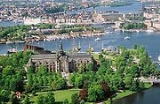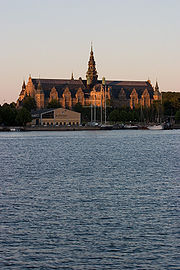
Nordic Museum
Encyclopedia
The Nordic Museum is a museum
located on Djurgården, an island in central Stockholm
, Sweden
, dedicated to the cultural history
and ethnography
of Sweden
from the Early Modern age (which for purposes of Swedish history is said to begin in 1520) until the contemporary period. The museum was founded in the late 19th century by Artur Hazelius
, who also founded the open-air museum Skansen
, long part of the museum, until the institutions were made independent of each other in 1963.
in 1891, it was the second such museum in the world. For the Nordic museum, Hazelius bought or managed to get donations of objects – furniture, clothes, toys etc. – from all over Sweden and the other Nordic countries; he was mainly interested in peasant culture but his successors increasingly started to collect objects reflecting bourgeois and urban lifestyles as well. For Skansen he collected entire buildings and farms.
For the Nordic museum, Hazelius bought or managed to get donations of objects – furniture, clothes, toys etc. – from all over Sweden and the other Nordic countries; he was mainly interested in peasant culture but his successors increasingly started to collect objects reflecting bourgeois and urban lifestyles as well. For Skansen he collected entire buildings and farms.
Although the project did not initially get the government funding he had hoped, Hazelius received widespread support and donations, and by 1898 the Society for the promotion of the Nordic Museum (Samfundet för Nordiska Museets främjande) had 4,525 members. The Swedish parliament
allocated some money for the museums in 1891 and doubled the amount in 1900, the year before the death of Hazelius.
, was completed in 1907. Originally, it was intended to be a national monument housing the material inheritance of the nation. It was, however, only half-completed for the Stockholm Exposition 1897
, and it never was completed to the extent originally planned, three times the actual size. It takes its style from Dutch-influenced Danish Renaissance architecture
(i.e. buildings such as Frederiksborg Palace
) rather than any specifically Swedish historical models. The core of the "cathedralesque" building is taken up by a huge main hall passing through all the stories up to the roof and dominated by the enormous sculpture of King Gustav Vasa
, the Swedish so called founder-king. For the construction, brick and granite was used for the walls, while concrete was used for the roof.
Museum
A museum is an institution that cares for a collection of artifacts and other objects of scientific, artistic, cultural, or historical importance and makes them available for public viewing through exhibits that may be permanent or temporary. Most large museums are located in major cities...
located on Djurgården, an island in central Stockholm
Stockholm
Stockholm is the capital and the largest city of Sweden and constitutes the most populated urban area in Scandinavia. Stockholm is the most populous city in Sweden, with a population of 851,155 in the municipality , 1.37 million in the urban area , and around 2.1 million in the metropolitan area...
, Sweden
Sweden
Sweden , officially the Kingdom of Sweden , is a Nordic country on the Scandinavian Peninsula in Northern Europe. Sweden borders with Norway and Finland and is connected to Denmark by a bridge-tunnel across the Öresund....
, dedicated to the cultural history
Cultural history
The term cultural history refers both to an academic discipline and to its subject matter.Cultural history, as a discipline, at least in its common definition since the 1970s, often combines the approaches of anthropology and history to look at popular cultural traditions and cultural...
and ethnography
Ethnography
Ethnography is a qualitative method aimed to learn and understand cultural phenomena which reflect the knowledge and system of meanings guiding the life of a cultural group...
of Sweden
Sweden
Sweden , officially the Kingdom of Sweden , is a Nordic country on the Scandinavian Peninsula in Northern Europe. Sweden borders with Norway and Finland and is connected to Denmark by a bridge-tunnel across the Öresund....
from the Early Modern age (which for purposes of Swedish history is said to begin in 1520) until the contemporary period. The museum was founded in the late 19th century by Artur Hazelius
Artur Hazelius
Artur Immanuel Hazelius , Swedish teacher, scholar and folklorist, founder of the Nordic Museum and the open-air museum Skansen in Stockholm....
, who also founded the open-air museum Skansen
Skansen
Skansen is the first open air museum and zoo in Sweden and is located on the island Djurgården in Stockholm, Sweden. It was founded in 1891 by Artur Hazelius to show the way of life in the different parts of Sweden before the industrial era....
, long part of the museum, until the institutions were made independent of each other in 1963.
History
The Museum was originally (1873) called the Scandinavian ethnographic collection (Skandinavisk-etnografiska samlingen), from 1880 the Nordic Museum (Nordiska Museum, now Nordiska museet). When Hazelius established the open-air museum SkansenSkansen
Skansen is the first open air museum and zoo in Sweden and is located on the island Djurgården in Stockholm, Sweden. It was founded in 1891 by Artur Hazelius to show the way of life in the different parts of Sweden before the industrial era....
in 1891, it was the second such museum in the world.

Although the project did not initially get the government funding he had hoped, Hazelius received widespread support and donations, and by 1898 the Society for the promotion of the Nordic Museum (Samfundet för Nordiska Museets främjande) had 4,525 members. The Swedish parliament
Parliament of Sweden
The Riksdag is the national legislative assembly of Sweden. The riksdag is a unicameral assembly with 349 members , who are elected on a proportional basis to serve fixed terms of four years...
allocated some money for the museums in 1891 and doubled the amount in 1900, the year before the death of Hazelius.
Building
The present building, the design of Isak Gustaf ClasonIsak Gustaf Clason
Isak Gustaf Clason was a Swedish architect.- Biography :Clason studied engineering and later architecture at the Institute of Technology in Stockholm, where he was a student of A. T. Gellerstedt, and later at the architectural school of the Academy of Arts, at the time headed by Fredrik Wilhelm...
, was completed in 1907. Originally, it was intended to be a national monument housing the material inheritance of the nation. It was, however, only half-completed for the Stockholm Exposition 1897
General Art and Industrial Exposition of Stockholm (1897)
The General Art and Industrial Exposition of Stockholm of 1897 also known as Stockholm Exhibition or Stockholm World's Fair was a World's Fair staged in 1897 in Stockholm, Sweden....
, and it never was completed to the extent originally planned, three times the actual size. It takes its style from Dutch-influenced Danish Renaissance architecture
Renaissance architecture
Renaissance architecture is the architecture of the period between the early 15th and early 17th centuries in different regions of Europe, demonstrating a conscious revival and development of certain elements of ancient Greek and Roman thought and material culture. Stylistically, Renaissance...
(i.e. buildings such as Frederiksborg Palace
Frederiksborg Palace
Frederiksborg castle is a castle in Hillerød, Denmark. It was built as a royal residence for King Christian IV, and is now known as The Museum of National History. The current building replaced a previous castle erected by Frederick II, and is the largest Renaissance palace in Scandinavia...
) rather than any specifically Swedish historical models. The core of the "cathedralesque" building is taken up by a huge main hall passing through all the stories up to the roof and dominated by the enormous sculpture of King Gustav Vasa
Gustav I of Sweden
Gustav I of Sweden, born Gustav Eriksson of the Vasa noble family and later known simply as Gustav Vasa , was King of Sweden from 1523 until his death....
, the Swedish so called founder-king. For the construction, brick and granite was used for the walls, while concrete was used for the roof.

